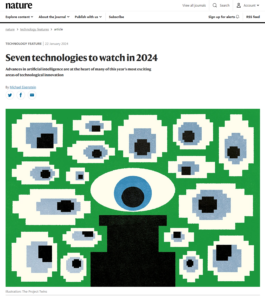Seven science technologies to watch in 2024 according to Nature
Advances in artificial intelligence are at the heart of many of this year’s most exciting areas of technological innovation
 #1 Deep learning for protein design
#1 Deep learning for protein design
Scientists are making leaps in protein design, harnessing the power of deep learning to create custom-made proteins for a myriad of purposes — from crafting stable synthetic proteins for enzyme production to designing vehicles for drug delivery.
#2 Deepfake detection
With multiple ongoing geopolitical conflicts and a US presidential election on the horizon, opportunities for weaponized media manipulation are rife. Researchers are innovating ways to identify manipulated media, from embedding hidden signals in AI-generated content to scrutinizing facial features for anomalies. Despite progress, the challenge lies in implementing these solutions effectively, and as reported in Nature, major social media sites are not routinely employing them.
[table “58” not found /]#3 Large-fragment DNA insertion
In late 2023, US and UK regulators approved the first-ever CRISPR-based gene-editing therapy for sickle-cell disease and transfusion-dependent β-thalassaemia — a major win for genome editing as a clinical tool. Groundbreaking techniques like prime editing and programmable addition through site-specific targeting elements (PASTE) offer hope for precise insertion of large DNA fragments into the genome, potentially revolutionizing treatments for genetic disorders and even endowing food crops with disease resistance.
#4 Brain-computer interfaces (BCIs)
Pat Bennett has slower than average speech, and can sometimes use the wrong word. But given that motor neuron disease, also known as amyotrophic lateral sclerosis, had previously left her unable to express herself verbally, that is a remarkable achievement. Bennett’s recovery comes courtesy of a sophisticated BCI device developed by Stanford University neuroscientist Francis Willett and his colleagues at the US-based BrainGate consortium. BrainGate’s trial is just one of several studies from the past few years demonstrating how BCI technology can help people with severe neurological damage to regain lost skills and achieve greater independence.
#5 Super-duper resolution
Advancements in super-resolution microscopy, such as MINSTED and resolution enhancement by sequential imaging (RESI), are unlocking unprecedented insights into cellular structures and biomolecular interactions. These techniques offer researchers a window into the molecular world, fueling discoveries across science and medicine.
#6 Cell atlases
If you’re looking for a convenient cafe, Google Maps can find nearby options and tell you how to get there. There’s no equivalent for navigating the much more complex landscape of the human body, but ongoing progress from various cell-atlas initiatives — powered by advances in single-cell analysis and ‘spatial omics’ methods — could soon deliver the tissue-wide cellular maps that biologists crave.
#7 Nanomaterials printed in 3D
Weird and interesting things can happen at the nanometre scale. This can make materials-science predictions difficult, but it also means that nanoscale architects can manufacture lightweight materials with distinctive characteristics such as increased strength, tailored interactions with light or sound, and enhanced capacity for catalysis or energy storage. Several strategies exist for crafting such nanomaterials, most of which use lasers to induce ‘photopolymerization’ of light-sensitive materials, and over the past few years, scientists have made considerable headway in overcoming the limitations that have impeded broader adoption of these methods.
ChatGPT? Maybe next year
Readers might detect one such tool did not make the final cut: the much-hyped artificial-intelligence (AI)-powered chatbots. Respondents to a Nature survey in 2023 cited ChatGPT as the most useful AI-based tool. However, many of these applications represent labour-saving gains rather than transformations of the research process. Furthermore, ChatGPT’s persistent misleading or fabricated responses were the leading concern of more than two-thirds of survey respondents. Although worth monitoring, these tools need time to mature and establish their role in the scientific world.
View the full article in Nature >>
